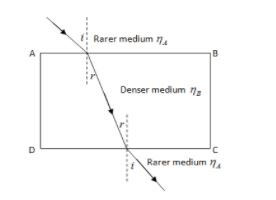
What do you mean by refraction of light. What is the basic cause of refraction?
Answer
580.8k+ views
Hint: Refraction is a process where it describes how the behavior of light changes as it enters from one medium to another. The explanation to the behavior is basically explained by Fermat’s principle. If the light enters from a rarer medium to a denser medium the ray of light bends towards the normal. The extent to which the light shows variation in its behavior depends on the refractive index of the medium with respect to the refractive index of the medium from where the light is incident from.
Complete answer:
Let us first define the refractive index of a substance
Refractive index of a medium for a light of given wavelength can be defined as the ratio of speed of light in vacuum to that of the speed in the medium.
Mathematically expressed as $\eta =\dfrac{c}{v}...(1)$ where c is the speed of light in vacuum and v is the speed of light in medium.

According to Fermat’s principle the light in any medium tries to travel with the shortest path and has its minimum time in the medium. Let us say that the ray of light from the above diagram takes time t to travel from the surface AB to surface BC. Let the distance travelled by the light during this duration be D. Hence the time taken by the ray of light in the denser medium is given by using equation 1 we get,
$\begin{align}
& \text{ }\!\!\eta\!\!\text{ =}\dfrac{\text{c}}{\dfrac{\text{D}}{\text{t}}} \\
& \text{t =}\dfrac{\text{ }\!\!\eta\!\!\text{ D}}{\text{c}}...(2) \\
\end{align}$
From the above equation we can see that the time taken depends on the refractive index of the medium and the path traversed by the ray of light. The time taken by the light will be minimum only when the distance traversed will be minimum for a given medium.
Note: If the light should have taken a minimum path in the denser medium, then the question arises is why not the perpendicular distance. This does not take place because if we see the diagram when the light again travels from the denser to the rarer medium the incident and the emergent ray both become parallel to each other indicating that a given medium has a fixed velocity with which the light travels. If the ray of light had to become perpendicular the angle of incidence and the angle of emergence would have been the same but not parallel with respect to each other. Hence it would have violated the above statement.
Complete answer:
Let us first define the refractive index of a substance
Refractive index of a medium for a light of given wavelength can be defined as the ratio of speed of light in vacuum to that of the speed in the medium.
Mathematically expressed as $\eta =\dfrac{c}{v}...(1)$ where c is the speed of light in vacuum and v is the speed of light in medium.

According to Fermat’s principle the light in any medium tries to travel with the shortest path and has its minimum time in the medium. Let us say that the ray of light from the above diagram takes time t to travel from the surface AB to surface BC. Let the distance travelled by the light during this duration be D. Hence the time taken by the ray of light in the denser medium is given by using equation 1 we get,
$\begin{align}
& \text{ }\!\!\eta\!\!\text{ =}\dfrac{\text{c}}{\dfrac{\text{D}}{\text{t}}} \\
& \text{t =}\dfrac{\text{ }\!\!\eta\!\!\text{ D}}{\text{c}}...(2) \\
\end{align}$
From the above equation we can see that the time taken depends on the refractive index of the medium and the path traversed by the ray of light. The time taken by the light will be minimum only when the distance traversed will be minimum for a given medium.
Note: If the light should have taken a minimum path in the denser medium, then the question arises is why not the perpendicular distance. This does not take place because if we see the diagram when the light again travels from the denser to the rarer medium the incident and the emergent ray both become parallel to each other indicating that a given medium has a fixed velocity with which the light travels. If the ray of light had to become perpendicular the angle of incidence and the angle of emergence would have been the same but not parallel with respect to each other. Hence it would have violated the above statement.
Recently Updated Pages
Master Class 12 English: Engaging Questions & Answers for Success

Master Class 12 Business Studies: Engaging Questions & Answers for Success

Master Class 12 Economics: Engaging Questions & Answers for Success

Master Class 12 Social Science: Engaging Questions & Answers for Success

Master Class 12 Maths: Engaging Questions & Answers for Success

Master Class 12 Chemistry: Engaging Questions & Answers for Success

Trending doubts
What are the major means of transport Explain each class 12 social science CBSE

Which are the Top 10 Largest Countries of the World?

Draw a labelled sketch of the human eye class 12 physics CBSE

Explain sex determination in humans with line diag class 12 biology CBSE

The pH of the pancreatic juice is A 64 B 86 C 120 D class 12 biology CBSE

Explain sex determination in humans with the help of class 12 biology CBSE




